Accounting for Labour: Costs, Remuneration, and Efficiency Analysis
VerifiedAdded on 2022/06/08
|23
|6965
|14
Homework Assignment
AI Summary
This assignment provides a comprehensive overview of accounting for labor costs. It begins by distinguishing between direct and indirect labor costs, including basic pay, bonuses, and overtime premiums, with examples to illustrate calculations. The assignment then explores methods for relating labor costs to work done, such as time sheets, time cards, and job sheets, and explains the role of the payroll department in calculating gross and net wages. Furthermore, it delves into different remuneration methods, including time-based and piecework systems, as well as individual and group incentive schemes. The document also addresses the calculation and analysis of labor turnover, efficiency, capacity, and production volume ratios. Through detailed explanations and examples, the assignment equips students with the knowledge to effectively manage and account for labor costs within an organization.
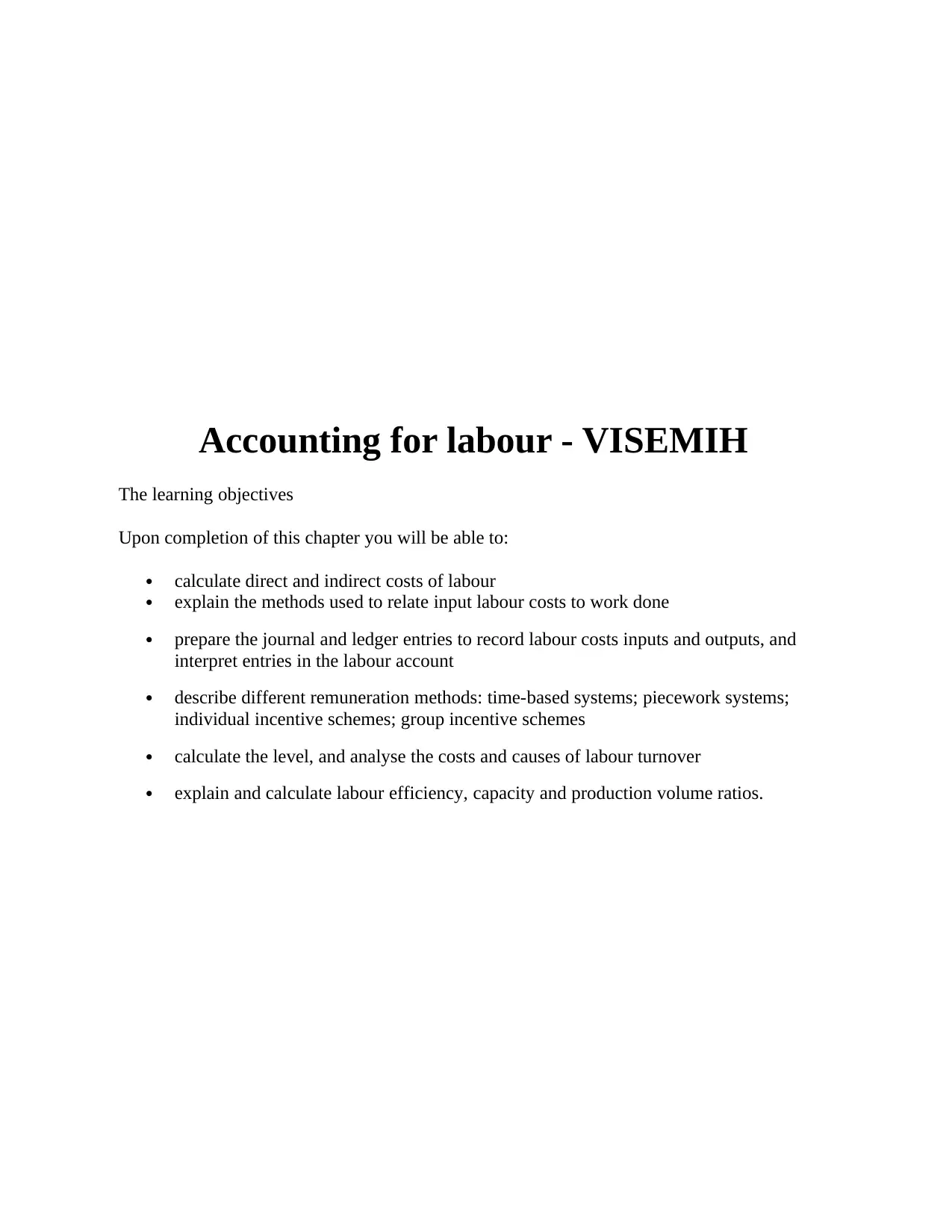
Accounting for labour - VISEMIH
The learning objectives
Upon completion of this chapter you will be able to:
calculate direct and indirect costs of labour
explain the methods used to relate input labour costs to work done
prepare the journal and ledger entries to record labour costs inputs and outputs, and
interpret entries in the labour account
describe different remuneration methods: time-based systems; piecework systems;
individual incentive schemes; group incentive schemes
calculate the level, and analyse the costs and causes of labour turnover
explain and calculate labour efficiency, capacity and production volume ratios.
The learning objectives
Upon completion of this chapter you will be able to:
calculate direct and indirect costs of labour
explain the methods used to relate input labour costs to work done
prepare the journal and ledger entries to record labour costs inputs and outputs, and
interpret entries in the labour account
describe different remuneration methods: time-based systems; piecework systems;
individual incentive schemes; group incentive schemes
calculate the level, and analyse the costs and causes of labour turnover
explain and calculate labour efficiency, capacity and production volume ratios.
Paraphrase This Document
Need a fresh take? Get an instant paraphrase of this document with our AI Paraphraser
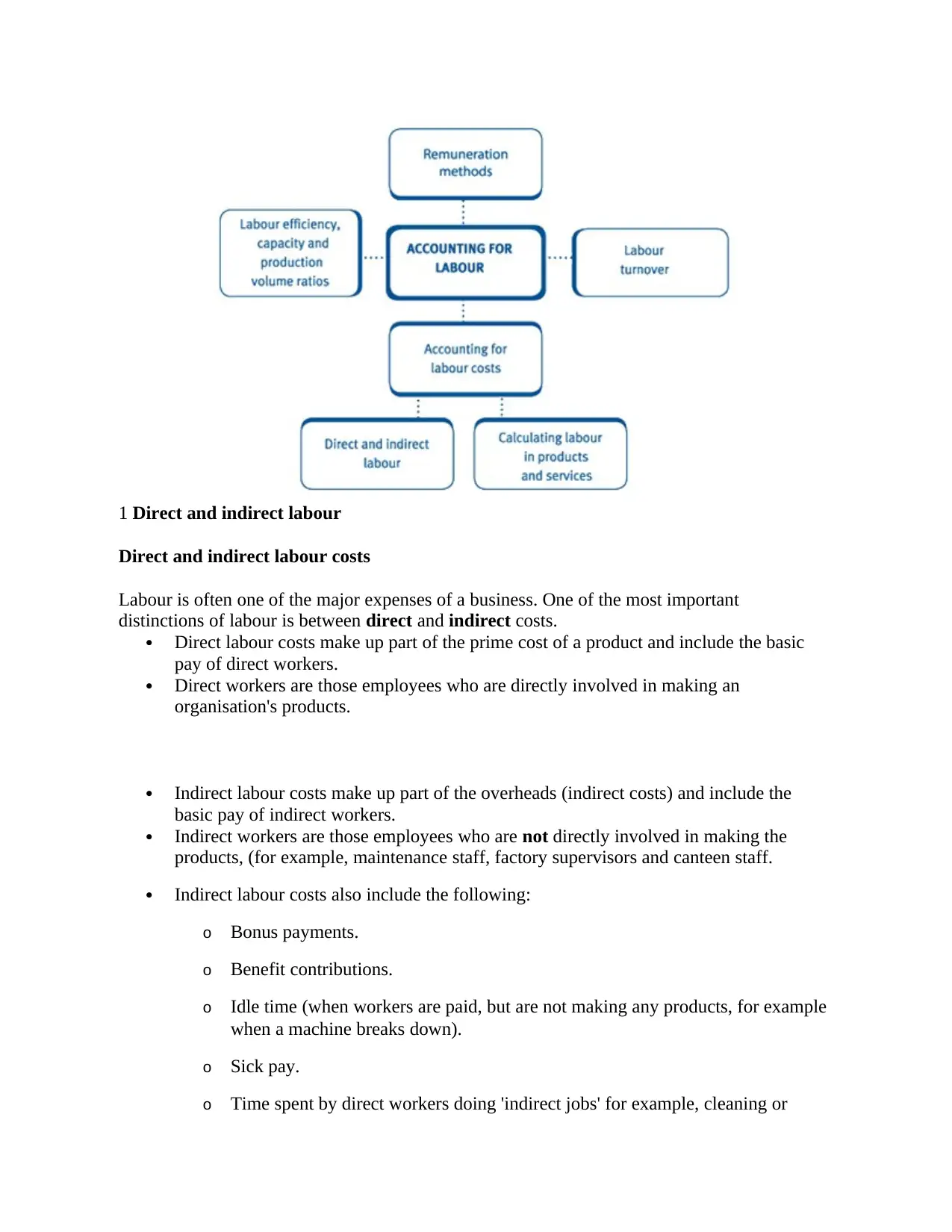
1 Direct and indirect labour
Direct and indirect labour costs
Labour is often one of the major expenses of a business. One of the most important
distinctions of labour is between direct and indirect costs.
Direct labour costs make up part of the prime cost of a product and include the basic
pay of direct workers.
Direct workers are those employees who are directly involved in making an
organisation's products.
Indirect labour costs make up part of the overheads (indirect costs) and include the
basic pay of indirect workers.
Indirect workers are those employees who are not directly involved in making the
products, (for example, maintenance staff, factory supervisors and canteen staff.
Indirect labour costs also include the following:
o Bonus payments.
o Benefit contributions.
o Idle time (when workers are paid, but are not making any products, for example
when a machine breaks down).
o Sick pay.
o Time spent by direct workers doing 'indirect jobs' for example, cleaning or
Direct and indirect labour costs
Labour is often one of the major expenses of a business. One of the most important
distinctions of labour is between direct and indirect costs.
Direct labour costs make up part of the prime cost of a product and include the basic
pay of direct workers.
Direct workers are those employees who are directly involved in making an
organisation's products.
Indirect labour costs make up part of the overheads (indirect costs) and include the
basic pay of indirect workers.
Indirect workers are those employees who are not directly involved in making the
products, (for example, maintenance staff, factory supervisors and canteen staff.
Indirect labour costs also include the following:
o Bonus payments.
o Benefit contributions.
o Idle time (when workers are paid, but are not making any products, for example
when a machine breaks down).
o Sick pay.
o Time spent by direct workers doing 'indirect jobs' for example, cleaning or
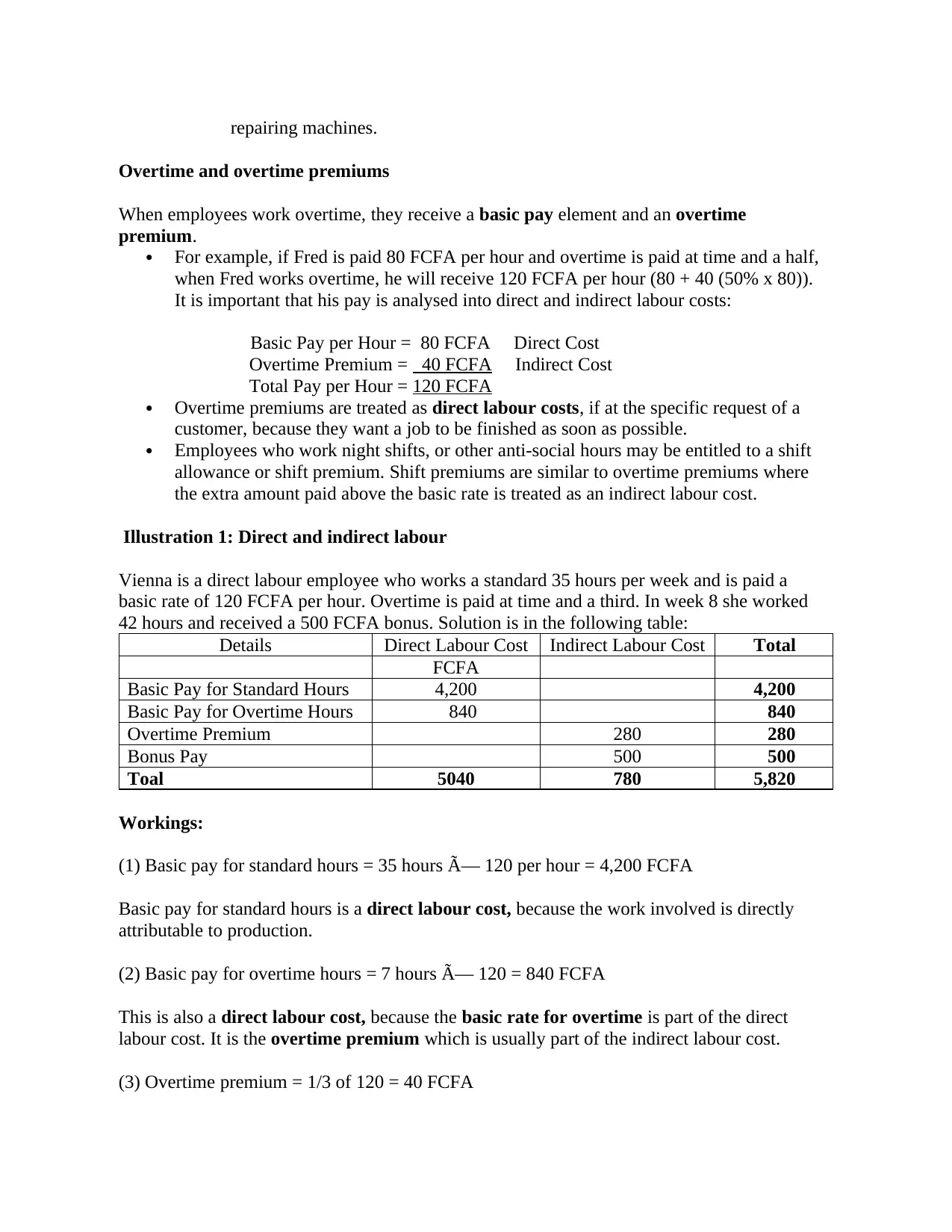
repairing machines.
Overtime and overtime premiums
When employees work overtime, they receive a basic pay element and an overtime
premium.
For example, if Fred is paid 80 FCFA per hour and overtime is paid at time and a half,
when Fred works overtime, he will receive 120 FCFA per hour (80 + 40 (50% x 80)).
It is important that his pay is analysed into direct and indirect labour costs:
Basic Pay per Hour = 80 FCFA Direct Cost
Overtime Premium = 40 FCFA Indirect Cost
Total Pay per Hour = 120 FCFA
Overtime premiums are treated as direct labour costs, if at the specific request of a
customer, because they want a job to be finished as soon as possible.
Employees who work night shifts, or other anti-social hours may be entitled to a shift
allowance or shift premium. Shift premiums are similar to overtime premiums where
the extra amount paid above the basic rate is treated as an indirect labour cost.
Illustration 1: Direct and indirect labour
Vienna is a direct labour employee who works a standard 35 hours per week and is paid a
basic rate of 120 FCFA per hour. Overtime is paid at time and a third. In week 8 she worked
42 hours and received a 500 FCFA bonus. Solution is in the following table:
Details Direct Labour Cost Indirect Labour Cost Total
FCFA
Basic Pay for Standard Hours 4,200 4,200
Basic Pay for Overtime Hours 840 840
Overtime Premium 280 280
Bonus Pay 500 500
Toal 5040 780 5,820
Workings:
(1) Basic pay for standard hours = 35 hours × 120 per hour = 4,200 FCFA
Basic pay for standard hours is a direct labour cost, because the work involved is directly
attributable to production.
(2) Basic pay for overtime hours = 7 hours × 120 = 840 FCFA
This is also a direct labour cost, because the basic rate for overtime is part of the direct
labour cost. It is the overtime premium which is usually part of the indirect labour cost.
(3) Overtime premium = 1/3 of 120 = 40 FCFA
Overtime and overtime premiums
When employees work overtime, they receive a basic pay element and an overtime
premium.
For example, if Fred is paid 80 FCFA per hour and overtime is paid at time and a half,
when Fred works overtime, he will receive 120 FCFA per hour (80 + 40 (50% x 80)).
It is important that his pay is analysed into direct and indirect labour costs:
Basic Pay per Hour = 80 FCFA Direct Cost
Overtime Premium = 40 FCFA Indirect Cost
Total Pay per Hour = 120 FCFA
Overtime premiums are treated as direct labour costs, if at the specific request of a
customer, because they want a job to be finished as soon as possible.
Employees who work night shifts, or other anti-social hours may be entitled to a shift
allowance or shift premium. Shift premiums are similar to overtime premiums where
the extra amount paid above the basic rate is treated as an indirect labour cost.
Illustration 1: Direct and indirect labour
Vienna is a direct labour employee who works a standard 35 hours per week and is paid a
basic rate of 120 FCFA per hour. Overtime is paid at time and a third. In week 8 she worked
42 hours and received a 500 FCFA bonus. Solution is in the following table:
Details Direct Labour Cost Indirect Labour Cost Total
FCFA
Basic Pay for Standard Hours 4,200 4,200
Basic Pay for Overtime Hours 840 840
Overtime Premium 280 280
Bonus Pay 500 500
Toal 5040 780 5,820
Workings:
(1) Basic pay for standard hours = 35 hours × 120 per hour = 4,200 FCFA
Basic pay for standard hours is a direct labour cost, because the work involved is directly
attributable to production.
(2) Basic pay for overtime hours = 7 hours × 120 = 840 FCFA
This is also a direct labour cost, because the basic rate for overtime is part of the direct
labour cost. It is the overtime premium which is usually part of the indirect labour cost.
(3) Overtime premium = 1/3 of 120 = 40 FCFA
⊘ This is a preview!⊘
Do you want full access?
Subscribe today to unlock all pages.

Trusted by 1+ million students worldwide
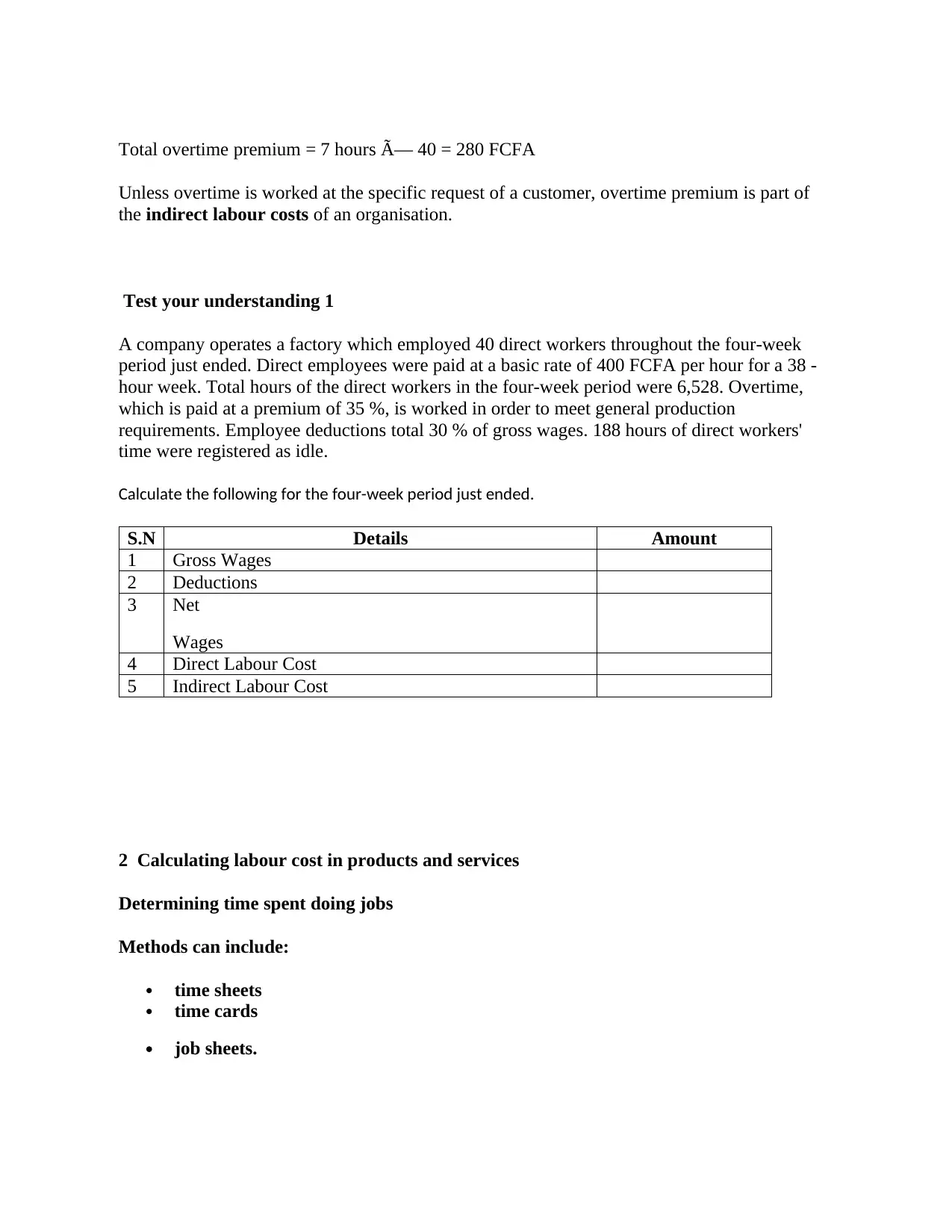
Total overtime premium = 7 hours × 40 = 280 FCFA
Unless overtime is worked at the specific request of a customer, overtime premium is part of
the indirect labour costs of an organisation.
Test your understanding 1
A company operates a factory which employed 40 direct workers throughout the four-week
period just ended. Direct employees were paid at a basic rate of 400 FCFA per hour for a 38 -
hour week. Total hours of the direct workers in the four-week period were 6,528. Overtime,
which is paid at a premium of 35 %, is worked in order to meet general production
requirements. Employee deductions total 30 % of gross wages. 188 hours of direct workers'
time were registered as idle.
Calculate the following for the four-week period just ended.
S.N Details Amount
1 Gross Wages
2 Deductions
3 Net
Wages
4 Direct Labour Cost
5 Indirect Labour Cost
2 Calculating labour cost in products and services
Determining time spent doing jobs
Methods can include:
time sheets
time cards
job sheets.
Unless overtime is worked at the specific request of a customer, overtime premium is part of
the indirect labour costs of an organisation.
Test your understanding 1
A company operates a factory which employed 40 direct workers throughout the four-week
period just ended. Direct employees were paid at a basic rate of 400 FCFA per hour for a 38 -
hour week. Total hours of the direct workers in the four-week period were 6,528. Overtime,
which is paid at a premium of 35 %, is worked in order to meet general production
requirements. Employee deductions total 30 % of gross wages. 188 hours of direct workers'
time were registered as idle.
Calculate the following for the four-week period just ended.
S.N Details Amount
1 Gross Wages
2 Deductions
3 Net
Wages
4 Direct Labour Cost
5 Indirect Labour Cost
2 Calculating labour cost in products and services
Determining time spent doing jobs
Methods can include:
time sheets
time cards
job sheets.
Paraphrase This Document
Need a fresh take? Get an instant paraphrase of this document with our AI Paraphraser
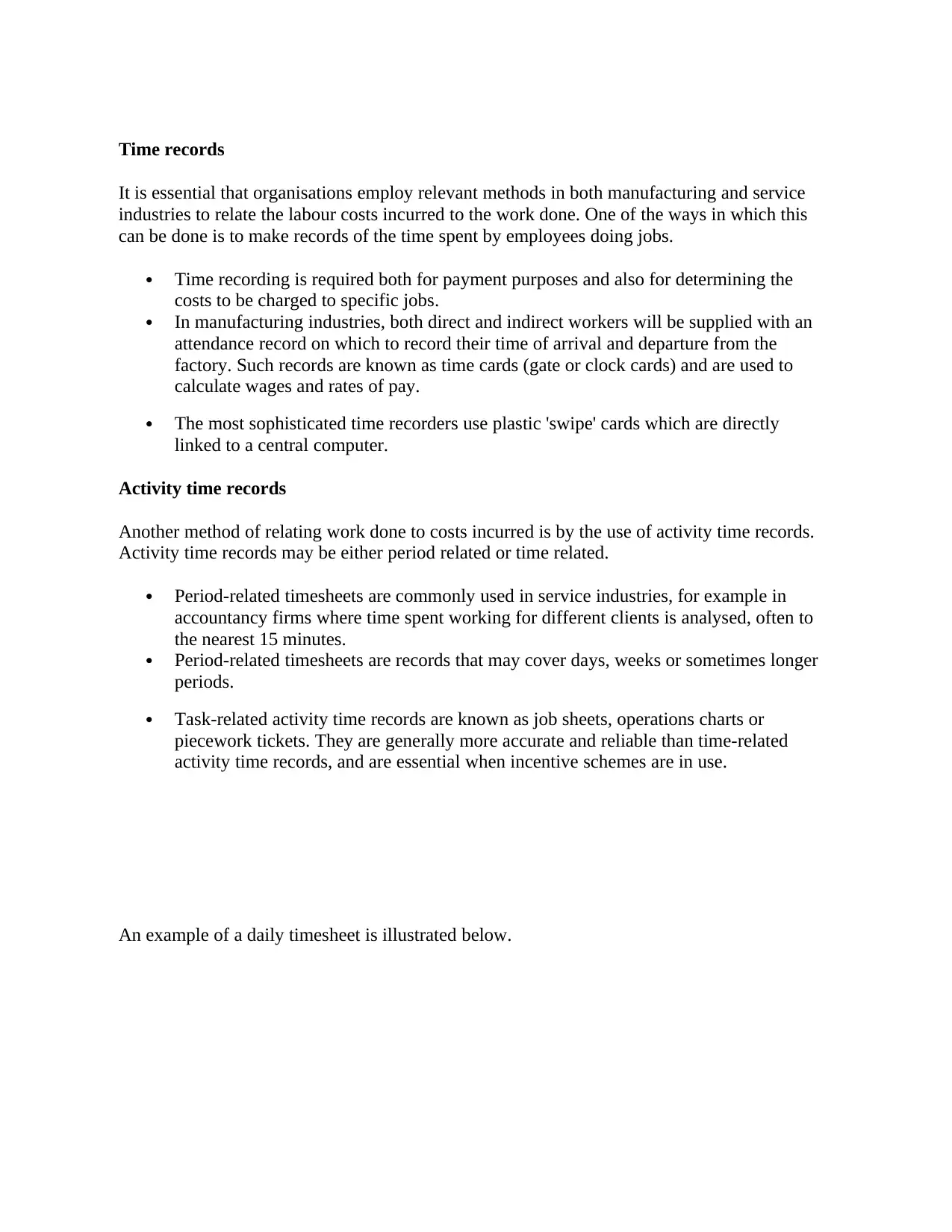
Time records
It is essential that organisations employ relevant methods in both manufacturing and service
industries to relate the labour costs incurred to the work done. One of the ways in which this
can be done is to make records of the time spent by employees doing jobs.
Time recording is required both for payment purposes and also for determining the
costs to be charged to specific jobs.
In manufacturing industries, both direct and indirect workers will be supplied with an
attendance record on which to record their time of arrival and departure from the
factory. Such records are known as time cards (gate or clock cards) and are used to
calculate wages and rates of pay.
The most sophisticated time recorders use plastic 'swipe' cards which are directly
linked to a central computer.
Activity time records
Another method of relating work done to costs incurred is by the use of activity time records.
Activity time records may be either period related or time related.
Period-related timesheets are commonly used in service industries, for example in
accountancy firms where time spent working for different clients is analysed, often to
the nearest 15 minutes.
Period-related timesheets are records that may cover days, weeks or sometimes longer
periods.
Task-related activity time records are known as job sheets, operations charts or
piecework tickets. They are generally more accurate and reliable than time-related
activity time records, and are essential when incentive schemes are in use.
An example of a daily timesheet is illustrated below.
It is essential that organisations employ relevant methods in both manufacturing and service
industries to relate the labour costs incurred to the work done. One of the ways in which this
can be done is to make records of the time spent by employees doing jobs.
Time recording is required both for payment purposes and also for determining the
costs to be charged to specific jobs.
In manufacturing industries, both direct and indirect workers will be supplied with an
attendance record on which to record their time of arrival and departure from the
factory. Such records are known as time cards (gate or clock cards) and are used to
calculate wages and rates of pay.
The most sophisticated time recorders use plastic 'swipe' cards which are directly
linked to a central computer.
Activity time records
Another method of relating work done to costs incurred is by the use of activity time records.
Activity time records may be either period related or time related.
Period-related timesheets are commonly used in service industries, for example in
accountancy firms where time spent working for different clients is analysed, often to
the nearest 15 minutes.
Period-related timesheets are records that may cover days, weeks or sometimes longer
periods.
Task-related activity time records are known as job sheets, operations charts or
piecework tickets. They are generally more accurate and reliable than time-related
activity time records, and are essential when incentive schemes are in use.
An example of a daily timesheet is illustrated below.
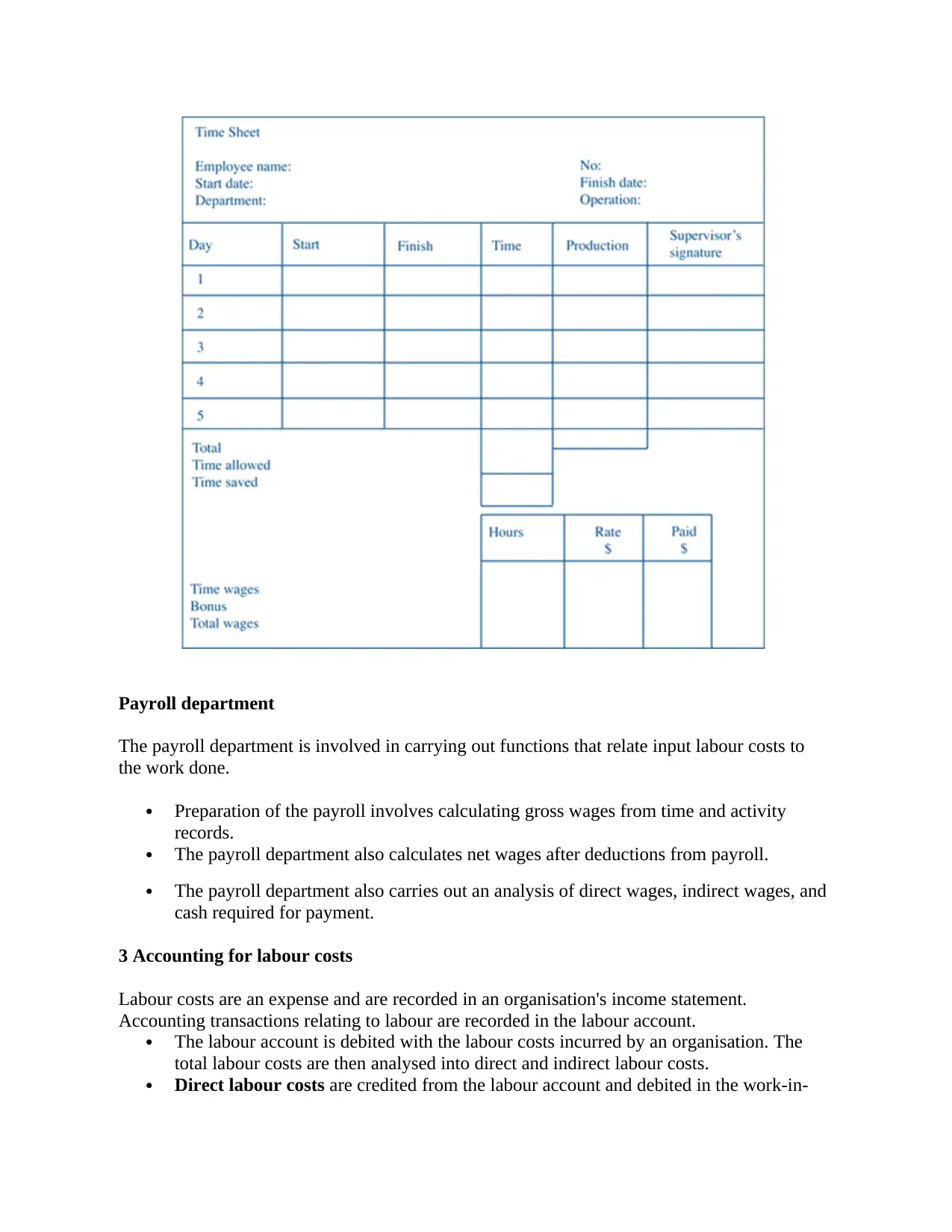
Payroll department
The payroll department is involved in carrying out functions that relate input labour costs to
the work done.
Preparation of the payroll involves calculating gross wages from time and activity
records.
The payroll department also calculates net wages after deductions from payroll.
The payroll department also carries out an analysis of direct wages, indirect wages, and
cash required for payment.
3 Accounting for labour costs
Labour costs are an expense and are recorded in an organisation's income statement.
Accounting transactions relating to labour are recorded in the labour account.
The labour account is debited with the labour costs incurred by an organisation. The
total labour costs are then analysed into direct and indirect labour costs.
Direct labour costs are credited from the labour account and debited in the work-in-
The payroll department is involved in carrying out functions that relate input labour costs to
the work done.
Preparation of the payroll involves calculating gross wages from time and activity
records.
The payroll department also calculates net wages after deductions from payroll.
The payroll department also carries out an analysis of direct wages, indirect wages, and
cash required for payment.
3 Accounting for labour costs
Labour costs are an expense and are recorded in an organisation's income statement.
Accounting transactions relating to labour are recorded in the labour account.
The labour account is debited with the labour costs incurred by an organisation. The
total labour costs are then analysed into direct and indirect labour costs.
Direct labour costs are credited from the labour account and debited in the work-in-
⊘ This is a preview!⊘
Do you want full access?
Subscribe today to unlock all pages.

Trusted by 1+ million students worldwide
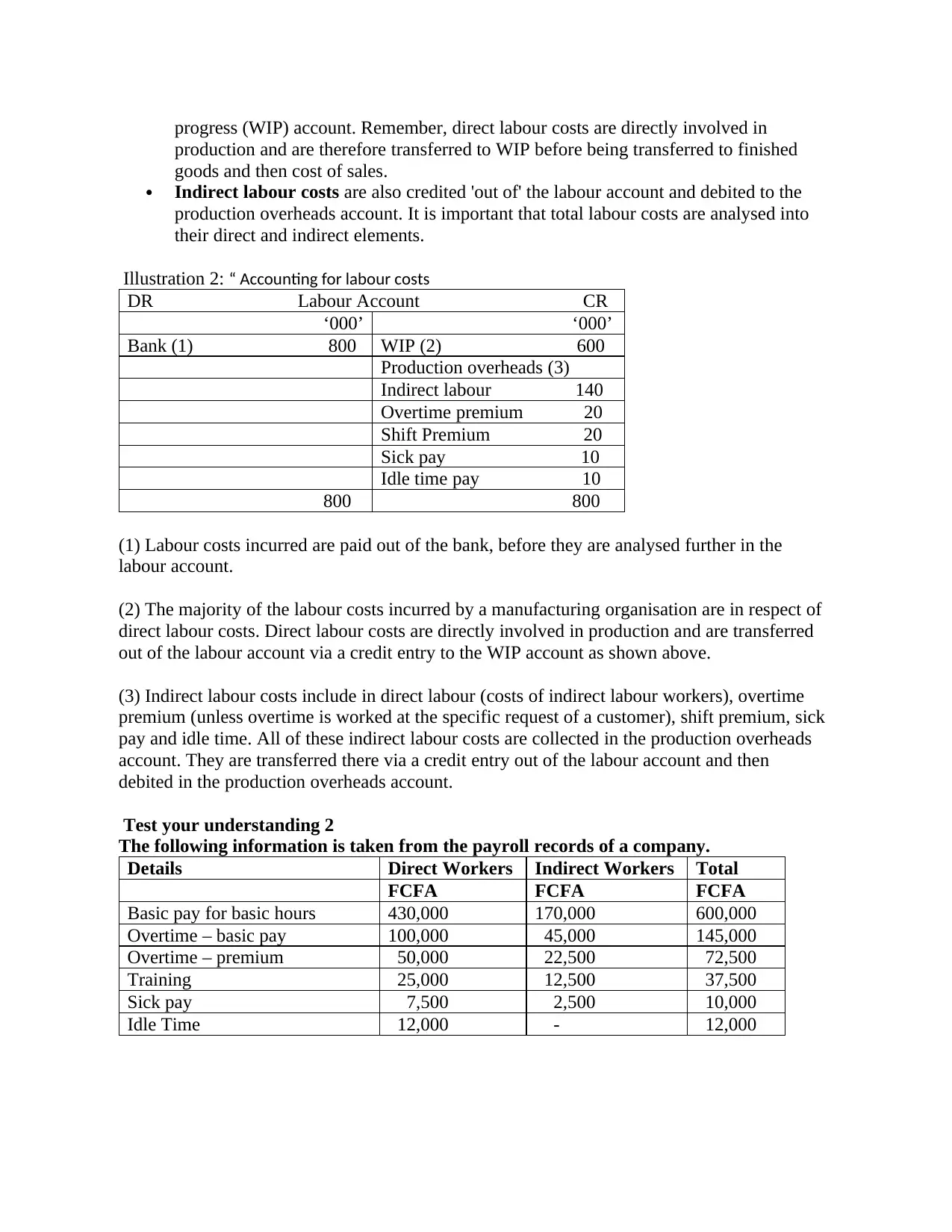
progress (WIP) account. Remember, direct labour costs are directly involved in
production and are therefore transferred to WIP before being transferred to finished
goods and then cost of sales.
Indirect labour costs are also credited 'out of' the labour account and debited to the
production overheads account. It is important that total labour costs are analysed into
their direct and indirect elements.
Illustration 2: “ Accounting for labour costs
DR Labour Account CR
‘000’ ‘000’
Bank (1) 800 WIP (2) 600
Production overheads (3)
Indirect labour 140
Overtime premium 20
Shift Premium 20
Sick pay 10
Idle time pay 10
800 800
(1) Labour costs incurred are paid out of the bank, before they are analysed further in the
labour account.
(2) The majority of the labour costs incurred by a manufacturing organisation are in respect of
direct labour costs. Direct labour costs are directly involved in production and are transferred
out of the labour account via a credit entry to the WIP account as shown above.
(3) Indirect labour costs include in direct labour (costs of indirect labour workers), overtime
premium (unless overtime is worked at the specific request of a customer), shift premium, sick
pay and idle time. All of these indirect labour costs are collected in the production overheads
account. They are transferred there via a credit entry out of the labour account and then
debited in the production overheads account.
Test your understanding 2
The following information is taken from the payroll records of a company.
Details Direct Workers Indirect Workers Total
FCFA FCFA FCFA
Basic pay for basic hours 430,000 170,000 600,000
Overtime – basic pay 100,000 45,000 145,000
Overtime – premium 50,000 22,500 72,500
Training 25,000 12,500 37,500
Sick pay 7,500 2,500 10,000
Idle Time 12,000 - 12,000
production and are therefore transferred to WIP before being transferred to finished
goods and then cost of sales.
Indirect labour costs are also credited 'out of' the labour account and debited to the
production overheads account. It is important that total labour costs are analysed into
their direct and indirect elements.
Illustration 2: “ Accounting for labour costs
DR Labour Account CR
‘000’ ‘000’
Bank (1) 800 WIP (2) 600
Production overheads (3)
Indirect labour 140
Overtime premium 20
Shift Premium 20
Sick pay 10
Idle time pay 10
800 800
(1) Labour costs incurred are paid out of the bank, before they are analysed further in the
labour account.
(2) The majority of the labour costs incurred by a manufacturing organisation are in respect of
direct labour costs. Direct labour costs are directly involved in production and are transferred
out of the labour account via a credit entry to the WIP account as shown above.
(3) Indirect labour costs include in direct labour (costs of indirect labour workers), overtime
premium (unless overtime is worked at the specific request of a customer), shift premium, sick
pay and idle time. All of these indirect labour costs are collected in the production overheads
account. They are transferred there via a credit entry out of the labour account and then
debited in the production overheads account.
Test your understanding 2
The following information is taken from the payroll records of a company.
Details Direct Workers Indirect Workers Total
FCFA FCFA FCFA
Basic pay for basic hours 430,000 170,000 600,000
Overtime – basic pay 100,000 45,000 145,000
Overtime – premium 50,000 22,500 72,500
Training 25,000 12,500 37,500
Sick pay 7,500 2,500 10,000
Idle Time 12,000 - 12,000
Paraphrase This Document
Need a fresh take? Get an instant paraphrase of this document with our AI Paraphraser
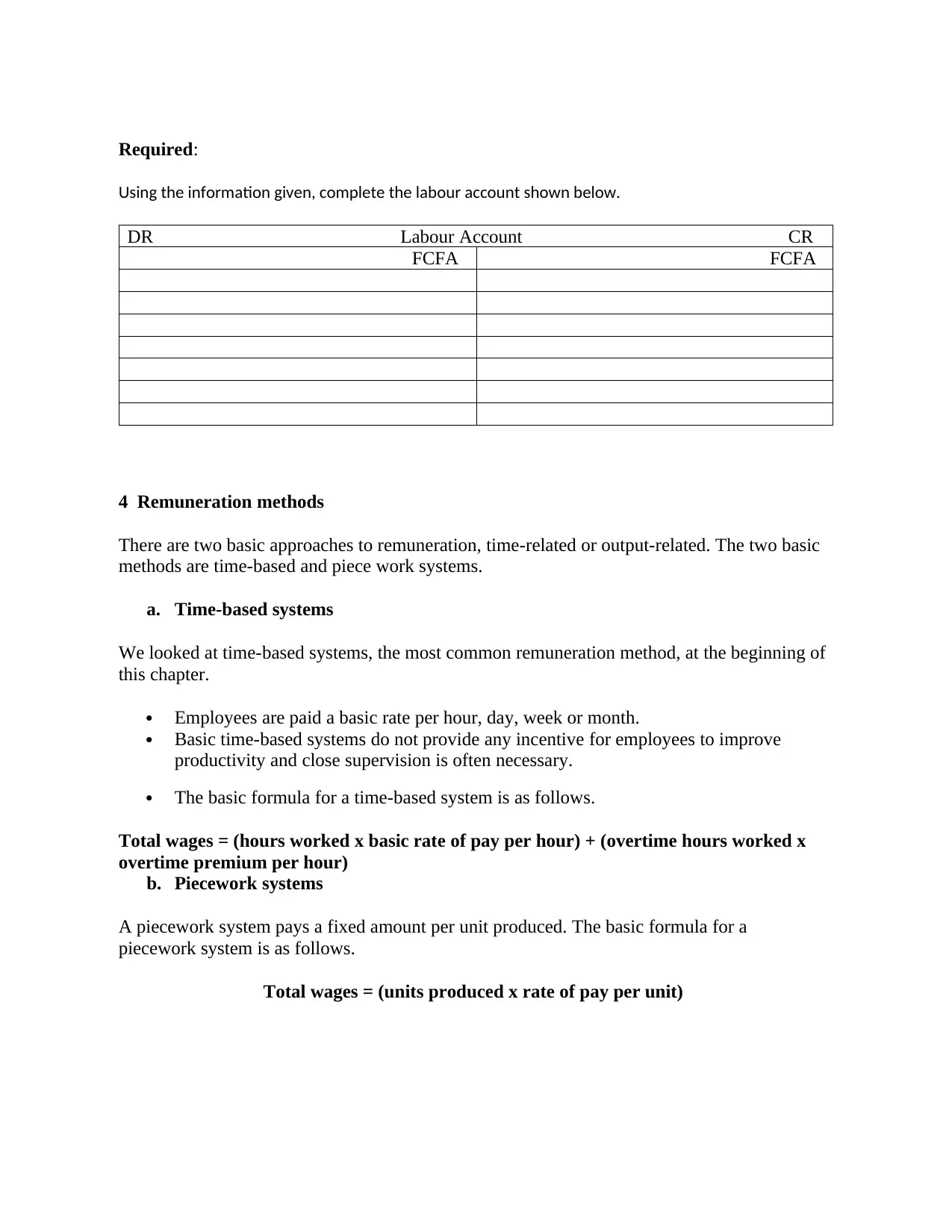
Required:
Using the information given, complete the labour account shown below.
DR Labour Account CR
FCFA FCFA
4 Remuneration methods
There are two basic approaches to remuneration, time-related or output-related. The two basic
methods are time-based and piece work systems.
a. Time-based systems
We looked at time-based systems, the most common remuneration method, at the beginning of
this chapter.
Employees are paid a basic rate per hour, day, week or month.
Basic time-based systems do not provide any incentive for employees to improve
productivity and close supervision is often necessary.
The basic formula for a time-based system is as follows.
Total wages = (hours worked x basic rate of pay per hour) + (overtime hours worked x
overtime premium per hour)
b. Piecework systems
A piecework system pays a fixed amount per unit produced. The basic formula for a
piecework system is as follows.
Total wages = (units produced x rate of pay per unit)
Using the information given, complete the labour account shown below.
DR Labour Account CR
FCFA FCFA
4 Remuneration methods
There are two basic approaches to remuneration, time-related or output-related. The two basic
methods are time-based and piece work systems.
a. Time-based systems
We looked at time-based systems, the most common remuneration method, at the beginning of
this chapter.
Employees are paid a basic rate per hour, day, week or month.
Basic time-based systems do not provide any incentive for employees to improve
productivity and close supervision is often necessary.
The basic formula for a time-based system is as follows.
Total wages = (hours worked x basic rate of pay per hour) + (overtime hours worked x
overtime premium per hour)
b. Piecework systems
A piecework system pays a fixed amount per unit produced. The basic formula for a
piecework system is as follows.
Total wages = (units produced x rate of pay per unit)
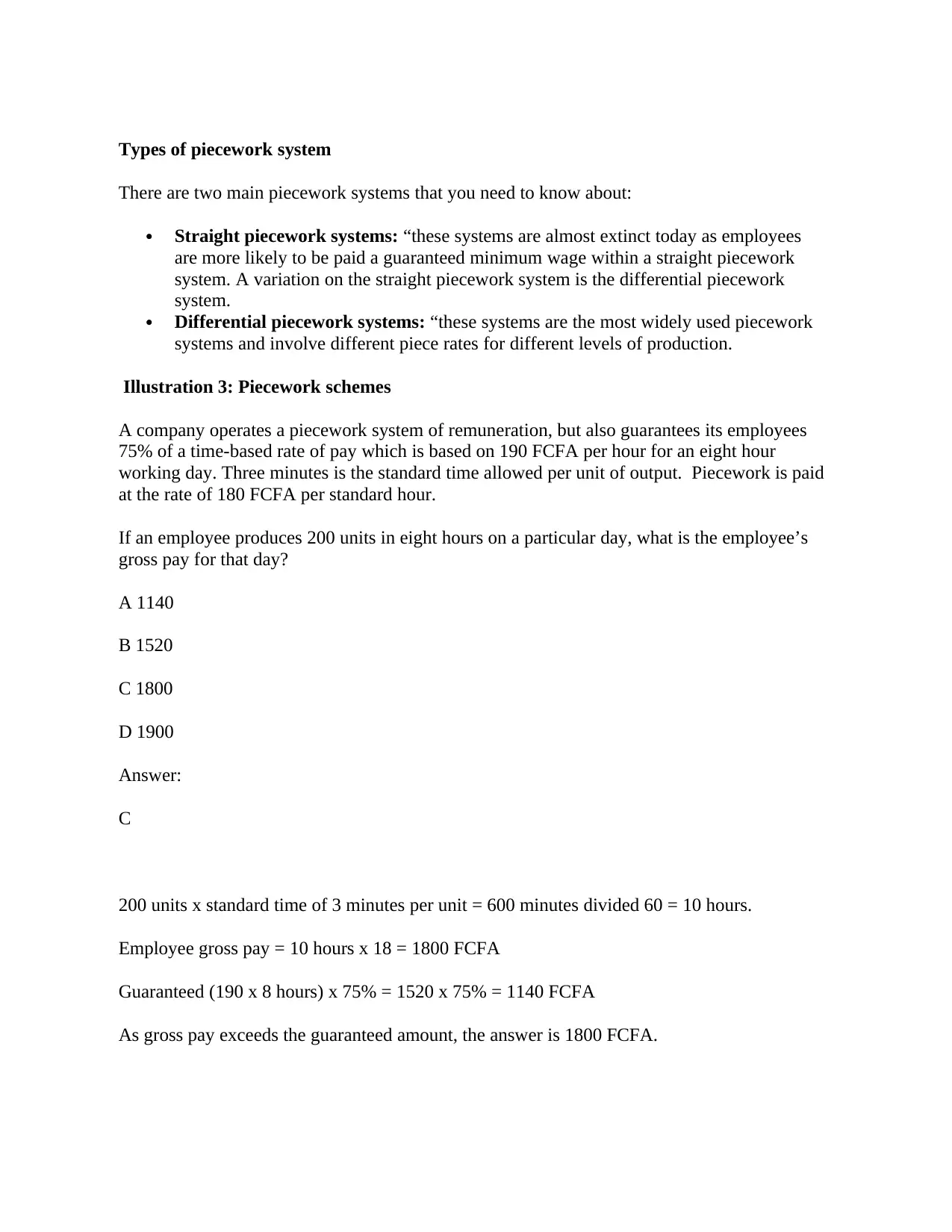
Types of piecework system
There are two main piecework systems that you need to know about:
Straight piecework systems: “these systems are almost extinct today as employees
are more likely to be paid a guaranteed minimum wage within a straight piecework
system. A variation on the straight piecework system is the differential piecework
system.
Differential piecework systems: “these systems are the most widely used piecework
systems and involve different piece rates for different levels of production.
Illustration 3: Piecework schemes
A company operates a piecework system of remuneration, but also guarantees its employees
75% of a time-based rate of pay which is based on 190 FCFA per hour for an eight hour
working day. Three minutes is the standard time allowed per unit of output. Piecework is paid
at the rate of 180 FCFA per standard hour.
If an employee produces 200 units in eight hours on a particular day, what is the employee’s
gross pay for that day?
A 1140
B 1520
C 1800
D 1900
Answer:
C
200 units x standard time of 3 minutes per unit = 600 minutes divided 60 = 10 hours.
Employee gross pay = 10 hours x 18 = 1800 FCFA
Guaranteed (190 x 8 hours) x 75% = 1520 x 75% = 1140 FCFA
As gross pay exceeds the guaranteed amount, the answer is 1800 FCFA.
There are two main piecework systems that you need to know about:
Straight piecework systems: “these systems are almost extinct today as employees
are more likely to be paid a guaranteed minimum wage within a straight piecework
system. A variation on the straight piecework system is the differential piecework
system.
Differential piecework systems: “these systems are the most widely used piecework
systems and involve different piece rates for different levels of production.
Illustration 3: Piecework schemes
A company operates a piecework system of remuneration, but also guarantees its employees
75% of a time-based rate of pay which is based on 190 FCFA per hour for an eight hour
working day. Three minutes is the standard time allowed per unit of output. Piecework is paid
at the rate of 180 FCFA per standard hour.
If an employee produces 200 units in eight hours on a particular day, what is the employee’s
gross pay for that day?
A 1140
B 1520
C 1800
D 1900
Answer:
C
200 units x standard time of 3 minutes per unit = 600 minutes divided 60 = 10 hours.
Employee gross pay = 10 hours x 18 = 1800 FCFA
Guaranteed (190 x 8 hours) x 75% = 1520 x 75% = 1140 FCFA
As gross pay exceeds the guaranteed amount, the answer is 1800 FCFA.
⊘ This is a preview!⊘
Do you want full access?
Subscribe today to unlock all pages.

Trusted by 1+ million students worldwide
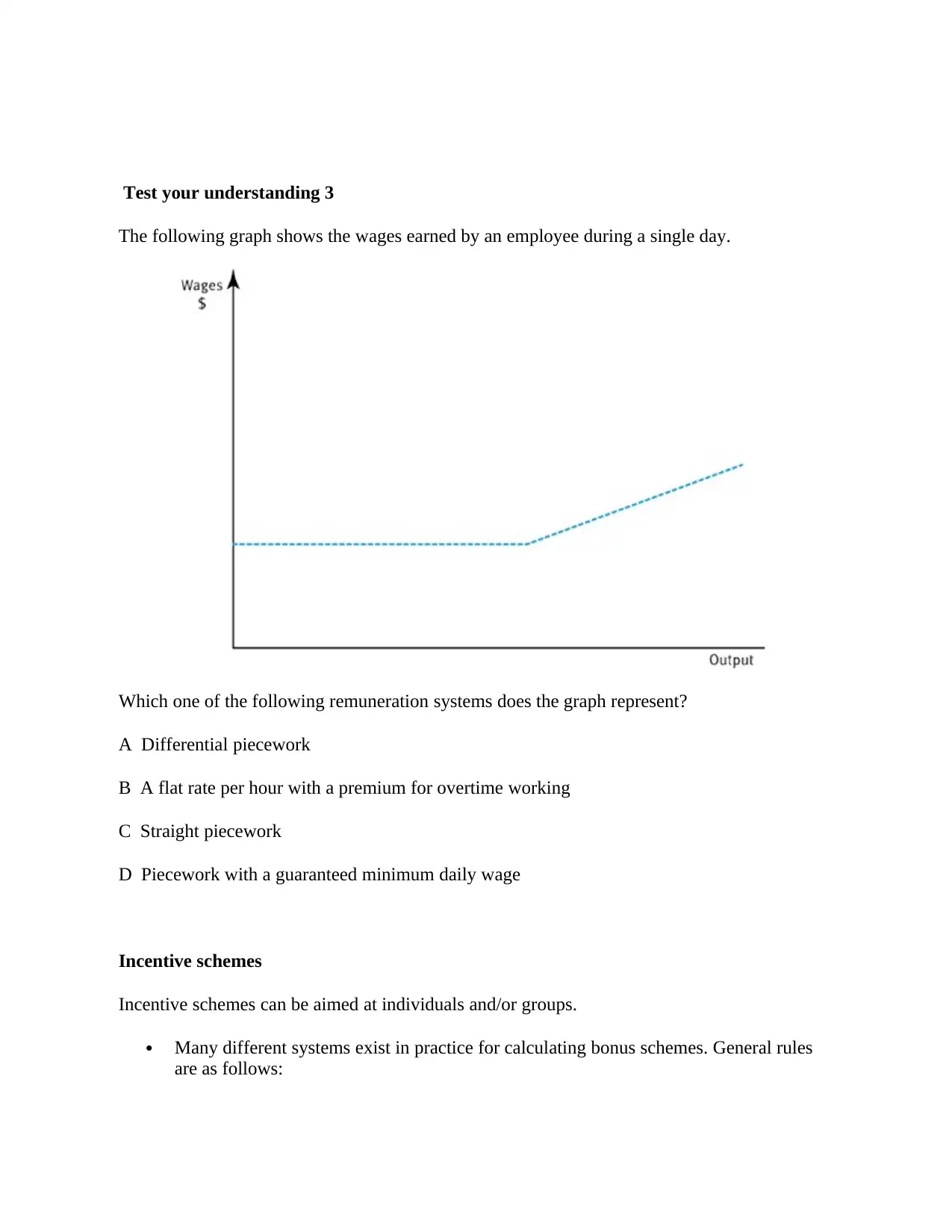
Test your understanding 3
The following graph shows the wages earned by an employee during a single day.
Which one of the following remuneration systems does the graph represent?
A Differential piecework
B A flat rate per hour with a premium for overtime working
C Straight piecework
D Piecework with a guaranteed minimum daily wage
Incentive schemes
Incentive schemes can be aimed at individuals and/or groups.
Many different systems exist in practice for calculating bonus schemes. General rules
are as follows:
The following graph shows the wages earned by an employee during a single day.
Which one of the following remuneration systems does the graph represent?
A Differential piecework
B A flat rate per hour with a premium for overtime working
C Straight piecework
D Piecework with a guaranteed minimum daily wage
Incentive schemes
Incentive schemes can be aimed at individuals and/or groups.
Many different systems exist in practice for calculating bonus schemes. General rules
are as follows:
Paraphrase This Document
Need a fresh take? Get an instant paraphrase of this document with our AI Paraphraser
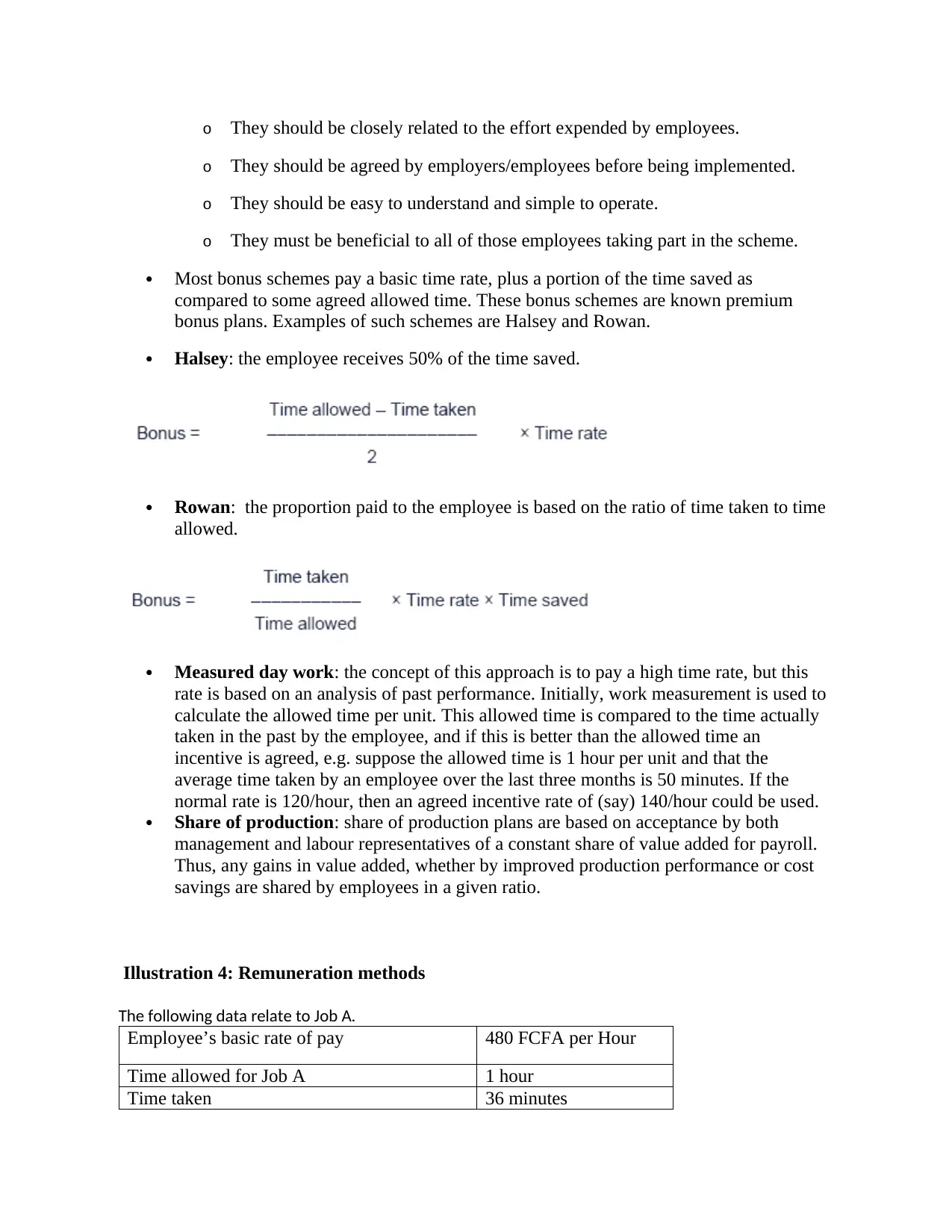
o They should be closely related to the effort expended by employees.
o They should be agreed by employers/employees before being implemented.
o They should be easy to understand and simple to operate.
o They must be beneficial to all of those employees taking part in the scheme.
Most bonus schemes pay a basic time rate, plus a portion of the time saved as
compared to some agreed allowed time. These bonus schemes are known premium
bonus plans. Examples of such schemes are Halsey and Rowan.
Halsey: the employee receives 50% of the time saved.
Rowan: the proportion paid to the employee is based on the ratio of time taken to time
allowed.
Measured day work: the concept of this approach is to pay a high time rate, but this
rate is based on an analysis of past performance. Initially, work measurement is used to
calculate the allowed time per unit. This allowed time is compared to the time actually
taken in the past by the employee, and if this is better than the allowed time an
incentive is agreed, e.g. suppose the allowed time is 1 hour per unit and that the
average time taken by an employee over the last three months is 50 minutes. If the
normal rate is 120/hour, then an agreed incentive rate of (say) 140/hour could be used.
Share of production: share of production plans are based on acceptance by both
management and labour representatives of a constant share of value added for payroll.
Thus, any gains in value added, whether by improved production performance or cost
savings are shared by employees in a given ratio.
Illustration 4: Remuneration methods
The following data relate to Job A.
Employee’s basic rate of pay 480 FCFA per Hour
Time allowed for Job A 1 hour
Time taken 36 minutes
o They should be agreed by employers/employees before being implemented.
o They should be easy to understand and simple to operate.
o They must be beneficial to all of those employees taking part in the scheme.
Most bonus schemes pay a basic time rate, plus a portion of the time saved as
compared to some agreed allowed time. These bonus schemes are known premium
bonus plans. Examples of such schemes are Halsey and Rowan.
Halsey: the employee receives 50% of the time saved.
Rowan: the proportion paid to the employee is based on the ratio of time taken to time
allowed.
Measured day work: the concept of this approach is to pay a high time rate, but this
rate is based on an analysis of past performance. Initially, work measurement is used to
calculate the allowed time per unit. This allowed time is compared to the time actually
taken in the past by the employee, and if this is better than the allowed time an
incentive is agreed, e.g. suppose the allowed time is 1 hour per unit and that the
average time taken by an employee over the last three months is 50 minutes. If the
normal rate is 120/hour, then an agreed incentive rate of (say) 140/hour could be used.
Share of production: share of production plans are based on acceptance by both
management and labour representatives of a constant share of value added for payroll.
Thus, any gains in value added, whether by improved production performance or cost
savings are shared by employees in a given ratio.
Illustration 4: Remuneration methods
The following data relate to Job A.
Employee’s basic rate of pay 480 FCFA per Hour
Time allowed for Job A 1 hour
Time taken 36 minutes
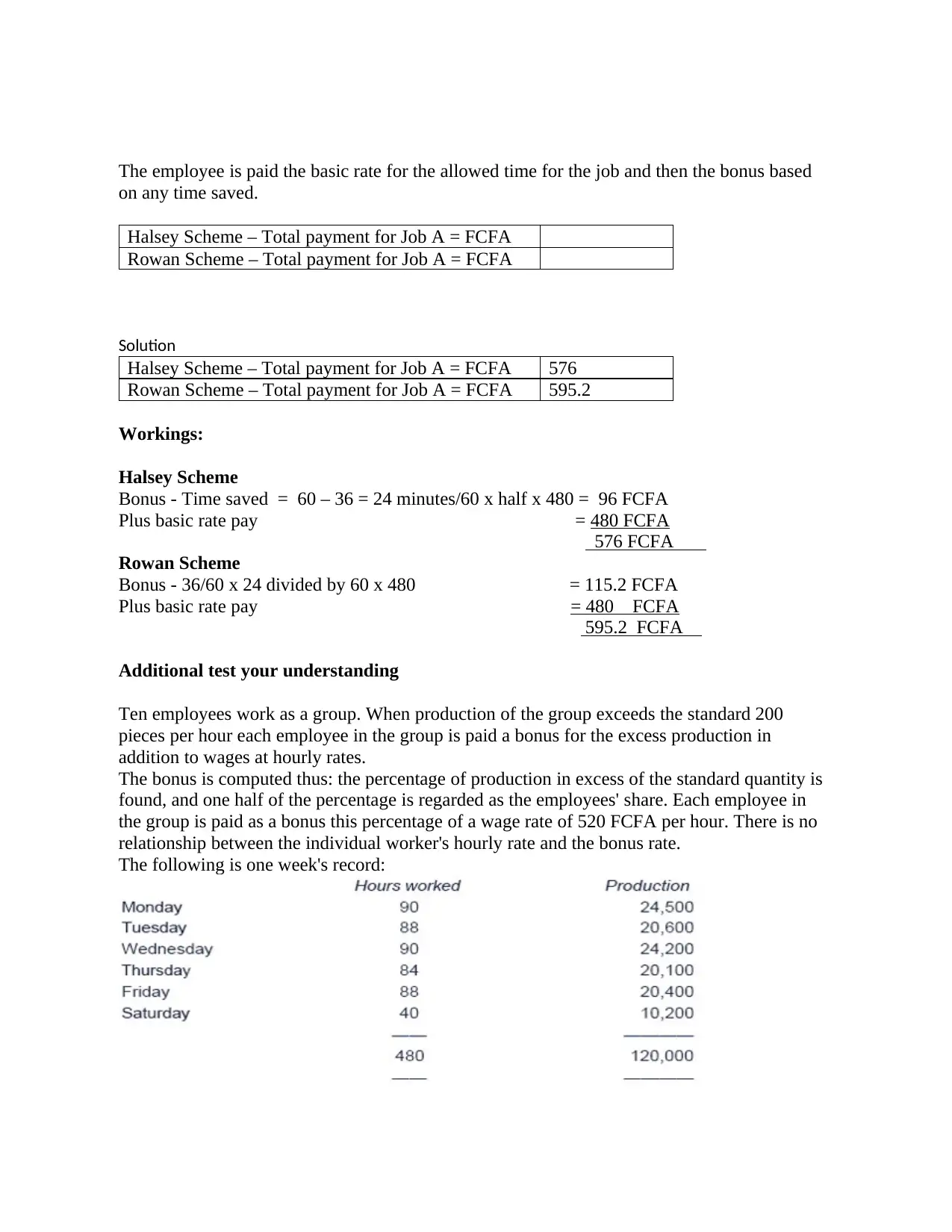
The employee is paid the basic rate for the allowed time for the job and then the bonus based
on any time saved.
Halsey Scheme – Total payment for Job A = FCFA
Rowan Scheme – Total payment for Job A = FCFA
Solution
Halsey Scheme – Total payment for Job A = FCFA 576
Rowan Scheme – Total payment for Job A = FCFA 595.2
Workings:
Halsey Scheme
Bonus - Time saved = 60 – 36 = 24 minutes/60 x half x 480 = 96 FCFA
Plus basic rate pay = 480 FCFA
576 FCFA
Rowan Scheme
Bonus - 36/60 x 24 divided by 60 x 480 = 115.2 FCFA
Plus basic rate pay = 480 FCFA
595.2 FCFA
Additional test your understanding
Ten employees work as a group. When production of the group exceeds the standard 200
pieces per hour each employee in the group is paid a bonus for the excess production in
addition to wages at hourly rates.
The bonus is computed thus: the percentage of production in excess of the standard quantity is
found, and one half of the percentage is regarded as the employees' share. Each employee in
the group is paid as a bonus this percentage of a wage rate of 520 FCFA per hour. There is no
relationship between the individual worker's hourly rate and the bonus rate.
The following is one week's record:
on any time saved.
Halsey Scheme – Total payment for Job A = FCFA
Rowan Scheme – Total payment for Job A = FCFA
Solution
Halsey Scheme – Total payment for Job A = FCFA 576
Rowan Scheme – Total payment for Job A = FCFA 595.2
Workings:
Halsey Scheme
Bonus - Time saved = 60 – 36 = 24 minutes/60 x half x 480 = 96 FCFA
Plus basic rate pay = 480 FCFA
576 FCFA
Rowan Scheme
Bonus - 36/60 x 24 divided by 60 x 480 = 115.2 FCFA
Plus basic rate pay = 480 FCFA
595.2 FCFA
Additional test your understanding
Ten employees work as a group. When production of the group exceeds the standard 200
pieces per hour each employee in the group is paid a bonus for the excess production in
addition to wages at hourly rates.
The bonus is computed thus: the percentage of production in excess of the standard quantity is
found, and one half of the percentage is regarded as the employees' share. Each employee in
the group is paid as a bonus this percentage of a wage rate of 520 FCFA per hour. There is no
relationship between the individual worker's hourly rate and the bonus rate.
The following is one week's record:
⊘ This is a preview!⊘
Do you want full access?
Subscribe today to unlock all pages.

Trusted by 1+ million students worldwide
1 out of 23
Related Documents
Your All-in-One AI-Powered Toolkit for Academic Success.
+13062052269
info@desklib.com
Available 24*7 on WhatsApp / Email
![[object Object]](/_next/static/media/star-bottom.7253800d.svg)
Unlock your academic potential
Copyright © 2020–2025 A2Z Services. All Rights Reserved. Developed and managed by ZUCOL.





